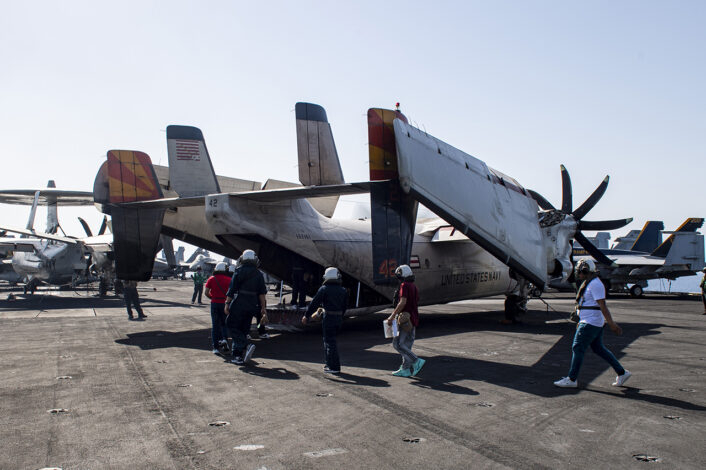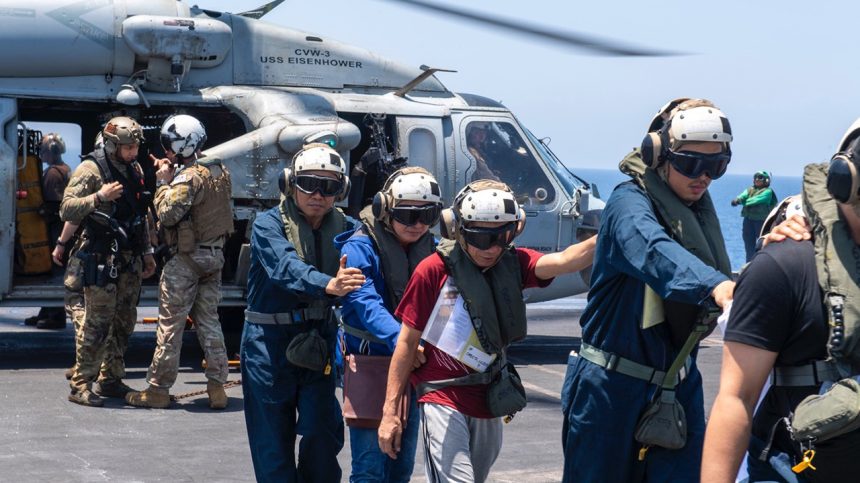Twenty four civilian crew members from a cargo vessel struck by a Houthi uncrewed surface vessel in the Red Sea have been rescued by the United States Navy.
M/V Tutor, a 229-meter Liberian flagged bulk cargo vessel, came under attack by a Houthi uncrewed surface vessel (USV) while sailing in the southern Red Sea on June 12, 2024. The USV impacted the ship’s stern and caused damage to the engine room along with severe flooding. Later that day, the ship’s crew reported that an unidentified airborne projectile had also struck the ship.
Footage showing the Moments right before as well as right after the Liberian-Flagged, Greek-Owned Bulk Cargo Ship, M/V Tutor was Struck on June 10th by a Houthi One-Way Surface Attack Drone while Transiting the Southern Red Sea. Armed Security Guards can be seen Observing the… pic.twitter.com/7khCPLQqnq
— OSINTdefender (@sentdefender) June 17, 2024
The incidents were reported to and managed by watchkeepers at United Kingdom Maritime Trade Operations (UKMTO) who provide an emergency coordination service between civilian mariners and maritime security forces.
UKMTO WARNING INCIDENT 083 ATTACK UPDATE 004
The crew of the vessel has been evacuated by military authorities. The vessel has been abandoned and is drifting in the vicinity and unlithttps://t.co/fX3hWupi7g#MaritimeSecurity #MarSec pic.twitter.com/uTH7R9RLDM
— United Kingdom Maritime Trade Operations (UKMTO) (@UK_MTO) June 14, 2024
A U.S. Navy MH-60R Seahawk helicopter embarked on the guided missile cruiser USS Philippine Sea (CG 58) was dispatched to aid the crew of M/V Tutor, with twenty four mariners eventually being rescued and returned to the cruiser. They were then transferred by helicopters from Helicopter Sea Combat Squadron (HSC) 7 to the aircraft carrier USS Dwight D. Eisenhower (CVN 69), which has now been deployed on operations for eight months.
After a medical check on the Eisenhower, which with a 53-bed hospital facility acts as the medical hub for its carrier strike group, the rescued sailors were flown ashore by a C-2A Greyhound carrier onboard delivery (COD) aircraft. One crew member from M/V Tutor remains missing.

On June 13, 2024, two missile attacks on the Ukrainian owned M/V Verbena saw one crew member evacuated with serious injuries, while the remaining crew managed to extinguish fires caused by the missile strikes and initially elected to continue with their journey. The following day the crew made a distress call stating their intent to abandon ship. A nearby merchant vessel responded to the call and rescued all crew members, while Iranian frigate Jamaran, operating eight nautical miles from Verbana, did not respond.
The U.S. Central Command statement on the two attacks reads “This continued malign and reckless behavior by the Iranian-backed Houthis threatens regional stability and endangers the lives of mariners across the Red Sea and Gulf of Aden. CENTCOM will continue to act with partners to hold the Houthis accountable and degrade their military capabilities.”.
Attacks on merchant shipping by the Iranian-backed Houthi group, who control a large part of western Yemen bordering the Red Sea, have been a constant threat since November 2023. Aligned with Hamas, the Houthis claim that their actions are focused on ships associated with Israel, although the actual attacks appear to be much more random. Some ships affected have even been carrying cargo destined for Iran, who are a major source of the weapons used by the group.
A coalition of military forces have been operating at a high tempo in the Red Sea and Gulf of Aden since the threat against commercial shipping became apparent. Ships and aircraft have downed missiles and unmanned aerial vehicles while counter-attacks have been launched to target the Houthi facilities and equipment suspected to be involved in conducting their campaign.
However, this attack represents the first successful strike in the current crisis using a USV. While these drone boats have seen use over the previous months, they have either malfunctioned or detonated prior to reaching their target or were intercepted by coalition military forces. Historically the Houthi rebels have demonstrated capability in this field with a successful attack on Saudi Arabian frigate Al Madinah in 2017, killing two and injuring three crew members.
Weaponry of this type is also seeing extensive use in the ongoing war in Ukraine. Ukraine has developed USVs such as the Magura V5, which it used to sink the Russian patrol ship Sergey Kotov. Novel capabilities have also been developed and fielded, utilising the unmanned boats to carry anti-air missiles. The Aviationist reported on such a capability in May, when a video emerged of a Russian Kamov Ka-27 helicopter engaging an R-73 missile equipped drone boat off the Crimean coast.
The threat posed by small, manoeuvrable watercraft has been a concern of many navies for quite some time. On Oct. 12, 2000, two members of Al-Qaeda piloted a small boat laden with C4 explosive towards the U.S. Navy destroyer USS Cole (DDG 67) in the Yemeni port of Aden and detonated the explosive in a suicide attack. The explosion killed fifteen aboard the Cole while injuring thirty seven more. U.S. Navy threat assessment protocols were reviewed following this attack, with the new Antiterrorism Force Protection Warfare Development Center forming at Naval Amphibious Base Little Creek to develop tactics and equipment to protect from future threats.
Over the following few years, ships were upgraded with new Mark 38 MGS Mod 2 25mm guns, which added an electro-optical/infrared (EO/IR) sight, laser rangefinder and remote control capability to the existing system as a better means of defence against small boats. An EO/IR system was also developed for the Phalanx close-in weapons system (CWIS) as part of the Block 1B upgrade, expanding its capability against surface threats as well as small UAVs.
Lightweight guided missiles tailored for use against small surface and air targets have been trialled and deployed by various nations. The U.S. Navy fields the Hydra 70 rocket based Advanced Precision Kill Weapons System (APKWS), which is able to be carried by the MH-60R Seahawk helicopters that always deploy with carrier strike groups. The United Kingdom’s Royal Navy now deploys the Martlet lightweight multi-role missile on its Wildcat helicopters, and has also tested the missile’s suitability for use on its surface vessels by adapting existing 30mm remote weapon mounts with additional missile launchers.
NEW: Amid an increasing threat from small boats used by terroists and suicide bombers, the Royal Navy has successfully tested the brand new Martlet missile.
HMS Sutherland fired four missiles at a fast moving speedboat off the Welsh coast. pic.twitter.com/Us9r3FnYDT
— Henry Jones (@hthjones) July 16, 2019
The main limiting factor for the protection of civilian vessels heading through the Red Sea continues to be the availability and positioning of coalition warships. While all the warships deployed for this mission theoretically have the capability to deal with the threat posed by small USVs and UAVs, with the higher degree of difficulty in their detection at range many are lacking in the ability to extend their protective bubble across a significant area in the same way that they can with long range anti-air missiles against traditional anti-ship missiles. With around 12% of the world’s trade passing through the Red Sea every year and only a comparative handful of warships able to be on station at any given time, there will always be gaps in the protective net.









